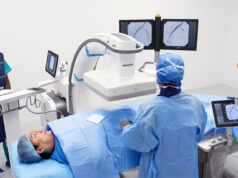 ControlRad has announced that the US Food and Drug Administration (FDA) has granted 510(k) clearance for its ControlRad Trace. The company has initiated its commercial launch. The ControlRad Trace is the only technology that can be integrated into existing mobile C-arms to reduce radiation in any fluoroscopic imaging procedure.
ControlRad has announced that the US Food and Drug Administration (FDA) has granted 510(k) clearance for its ControlRad Trace. The company has initiated its commercial launch. The ControlRad Trace is the only technology that can be integrated into existing mobile C-arms to reduce radiation in any fluoroscopic imaging procedure.
“Radiologists and our teams have grave concerns about the long-term effects from radiation exposure,” says John A Carrino, vice chairman of Radiology, Hospital for Special Surgery (New York, USA). “I am excited that new technology for mobile C-arms is now available because it has the potential to drastically improve our radiation safety while maintaining image quality so we can continue to effectively diagnose and treat our patients. I believe these new products should become the standard of care for fluoroscopic procedures.”
Fluoroscopically guided procedures with C-arms have allowed for major advances in treating countless diseases, however they expose patients and medical staff to ionising radiation, which may increase a person’s lifetime risk of developing cancer. For example, an interventional fluoroscopy procedure is roughly equivalent to the adult effective dose of between 250–3,500 chest X-rays.
“Radiation from C-arm procedures may increase the risk of brain cancer, cataracts, strokes and atherosclerosis,” says Guillaume Bailliard, ControlRad CEO. “It is our mission to dramatically reduce these life-altering radiation health risks to medical personnel and patients. This FDA clearance for ControlRad Trace allows us to provide our valuable radiation reduction technology to all mobile C-arm users looking to provide a safer environment without compromising patient care.”
With its proprietary semi-transparent filter, tablet and image processing technology, the ControlRad Trace solution can be retrofitted on existing C-arms, which, according to a press release, reduce the barrier to adopting the technology in order to reduce unnecessary radiation by up to 89%, without compromising image quality in the region of interest and overall workflow. The medical staff draws a region of interest on a ControlRad tablet, which in real-time optimises image quality in the region of interest while reducing unnecessary radiation in the periphery.













